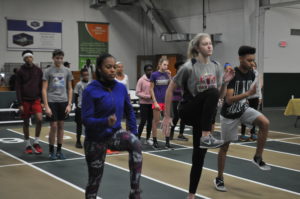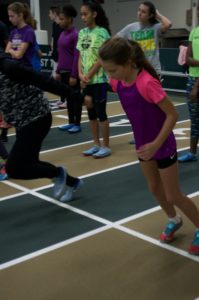Team Steve Speed & Hurdle Camp IV
by Steve McGill
On the weekend of November 10-11, my compadre Hector Cotto and I conducted our fourth Team Steve Speed & Hurdle Camp, and this was our third one at the JDL Fast Track in Winston Salem, NC. This one was our biggest camp of all so far – 49 campers from 13 state – and I would argue that it was our best one (partly because I always feel that the latest is the greatest, but also because the camaraderie among the athletes was the best that we’ve yet to have). The ages of the athletes ranged from 10 to 18, as we didn’t have any masters athletes sign up this time around. In terms of ability and experience, we had kids who have performed at a national level, kids who never hurdled before until arriving at the camp, and all levels of experience in between.
[am4show not_have=’g5;’]
[/am4show][am4guest]
[/am4guest][am4show have=’g5;’]
As I told the athletes as we wrapped up the second day, this camp, and all the camps I’ve done so far, represent me living my dream. My dream is to be available to any and all hurdlers who seek my guidance. Now that I’m at a point in my career where I’m not coaching for a school team and not coaching for a club team, where all my coaching is private coaching, I don’t have any conflicts of interest when it comes to coaching hurdlers outside my immediate circle. With this camp being our biggest one to date, I really felt like the dream had taken shape into a concrete reality. What made this camp so special was that the athletes really bonded with each other, and some genuine friendships were formed among athletes from different parts of the country. To me, that’s what it’s all about.
The format of the camp was a little different this time around, as I’m always looking to make minor tweaks to the program based on numbers and what we could’ve done better at previous camps. Usually, day one has been drill-heavy, and then day two focuses exclusively on speed. But we found in the first three camps that athletes were so sore from the drills on day one that they didn’t have as much pop in their legs for the speed work on day two. So, this time, we added in some speed on day one. Of course, the athletes were still very sore on day two, but at least we had gotten in some speed work first. Like I tell the kids at the beginning of each camp, we do a month’s work of hurdle work and pack it into two days. So, you’re going to be very sore when you leave, but you will have gained a lot of knowledge that you’ll be able to take back with you, and you’ll know what you need to do in order to continue to improve.
So on each day we have two major 2-hour sessions (after warmups in the morning, then after lunch in the afternoon). This time, on Saturday, the first session consisted of falling starts, three-point starts, four-point starts, and block starts, all without hurdles. We wanted to begin with hurdle-free starts because hurdlers tend to focus too much on the hurdle when the first hurdle is up, and we wanted to establish a sprinter’s mentality of driving aggressively with no popping up. The process for each type of start was the same: explain how to do it, have an experienced athlete demonstrate how to do it, then have all the kids line up and do them. We started with 20m drives, then 30m, then 40m. The goal each time was to hold the drive as long as possible, and to gradually rise to full height.
Back when I lived in Raleigh, my coaching friend Kevin Howell (who was one of the Team Steve staff members at the camp) and I would work side by side with athletes on weekends. With new hurdlers, he would work on their block setting and their block start; he would get them powering out of the blocks. Then, once they had that down, they’d move over a few lanes and work with me on their start to the first hurdle. That way, I knew I wouldn’t have to worry about them popping up and/or fixating on the first hurdle. So I based our plan for the weekend on that strategy. I also like for athletes to learn the different types of non-block starts available to them, as falling starts and three-point starts can be very useful in practice, and they also teach important things that will apply to block starts that must be learned before stepping into the blocks, such as maintaining forward angles, pushing pushing pushing, and coming out with an exaggerated arm swing.

Before every session, we practice sprint drills, and the A-skip is a primary staple. Knee up, heel up. (Some do it better than others).
For the afternoon session on day one, we taught the athletes some basic hurdle drills, starting with side walk-overs for lead leg and side walk-overs for trail leg. Like I told the kids, I’m not a fan of these drills because I’m not a fan of isolating either leg, and I don’t like the hurdlers to think in terms of one-two. The hurdle motion is one motion, not two separate motions. But side walk-overs are useful for teaching what each leg is supposed to do in the hurdling action. So we taught that, emphasizing a high knee action on both sides, emphasizing a tight trail leg that rises more up than out, and emphasizing dorsi-flexion every step of the way. From there, we introduced the marching popover – a staple for me regardless of the time of year. With that drill, we introduced the importance of pushing off the back leg with force while keeping the knee of the lead leg bent, and thrusting the hips forward in order to provide the horizontal element and avoid floating.
For the morning session of day two, we continued with drills, graduating from marching popovers into the cycle drill, where the march becomes a bounce on the balls of the feet action between the hurdles and the aim is to cycle the legs between the hurdles and over the hurdles. From there, we graduated to the quick-step drill, in which the hurdles are spaced farther apart and the speed between increases. The aim there is to learn to react to the hurdles when it feels like the hurdles are rushing up at you.
For the second session of day two (and the final session of the camp), we returned to starts, picking up from the first session of day one. Here, we did block starts over hurdles – with more advanced athletes the starts were competitive; for the less advanced we did more teaching and set them off one at a time.
We also squeezed some fence drill work on the second day, prior to the block starts, just so they had that to take home with them too. My style of teaching the fence drill for trail leg emphasizes a big push off the back leg. My style of teaching the fence drill for lead leg emphasizes a continuous cycle motion that causes you to fall forward when you do it correctly. So I wanted them to learn that so they could work on mastering it when they get home.
In addition, we spent about a half hour on one-step drills over the top, one of Hector Cotto’s favorite drills. (Hector, as you probably know, is the other main coach at the Team Steve camps). The one-step forces you to push off the back leg and to keep the lead leg knee bent, because if that foot kicks out you take away all the space you need to clear the hurdle.
So, by the end of day two, the athletes had learned everything we teach to our athletes whom we coach on a regular basis. The athletes whom I coach on a regular basis served as models for all the drills, and having them there was very helpful, because that peer-to-peer teaching can often be more effective than hearing a coach talking to you and explaining things to you.
The plan from here is to keep it moving. We’re planning on doing another one in March 2019. Right now I’m just waiting to hear back from the folks at JDL Fast Track so we can pinpoint a specific date.
[/am4show]


